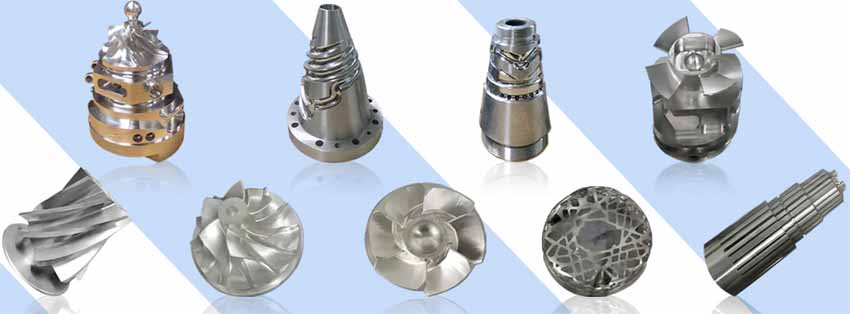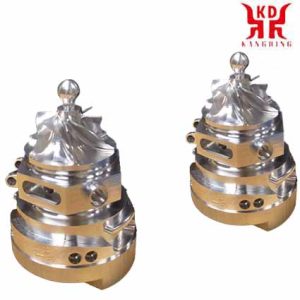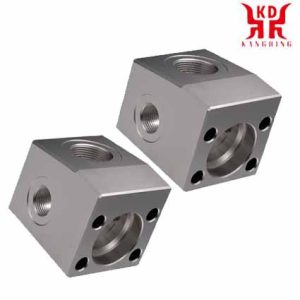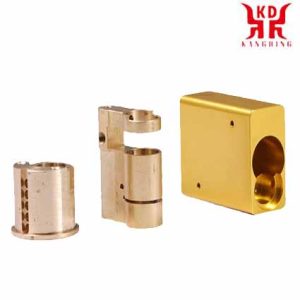
5-axis CNC machining method
How does CNC machining of parts of different materials (Aluminium, Edelstahl, Kupfer, Titan, Legierung, Plastik) work? Selection and setting of CNC tools.
Unter CNC-Teilebearbeitung versteht man eine Prozessmethode, die Informationen und digitale Geräte nutzt, um die Bewegung von Teilen und Fräsern zu steuern, um Teile auf einer CNC-Maschine zu bearbeiten. Es ist eine effektive Möglichkeit, variable Rapid-Prototyping-Komponenten zu lösen, Kleinserienteile, komplex geformte Teile und hochpräzise CNC-Bearbeitungskomponenten und erzielen hocheffiziente Teile.

Aluminum finishing with 5-axis CNC machining
CNC machining is a high-efficiency automatic machine tool composed of mechanical equipment and a numerical control system to process complex shaped workpieces.
The CNC machining center is a high mechatronics product. After clamping the workpiece, the CNC machining system can control the CNC machine tool to automatically select the device, automatically set the tool, automatically change the spindle speed, feeding, usw., different procedures.
Rapid prototyping CNC machining can continuously complete drilling and drilling. Various processes such as milling, reaming and threading greatly reduce additional process time such as time for clamping the workpiece, measuring and setting the machine tool.
The processing way is more complicated, the precision requirements are high, and the frequently replaced parts have strong economic effects.
CNC machining prototyping services have been used in various industrial sectors, but the aerospace industry has always been the most extensive CNC machine tool.
Some large aviation factories are equipped with hundreds of CNC machine tools, of which cutting machines are the main ones.
CNC machining parts include integral wall panels, beams, liners, bulkheads, propellers, aircraft engine housings, Wellen, discs, blades, and unique cavity surfaces of liquid rocket engine combustion chambers. The initial stage of development of CNC precision machining is based on continuous path CNC machine tools, continuous path control.

CNC-Bearbeitung zur Herstellung hochpräziser Werkstücke
What is CNC machining Parts used for?
1, CNC machining can be used to manufacture workpieces that are periodically put into production.
Market demand for some products is cyclical and seasonal. If a particular production line is used, the profit is not worth the loss. Processing efficiency with standard equipment is too low, quality is unstable, and quantity is difficult to guarantee.
The program and product-related information can be retained on the CNC machining center after the first part (batch) is cut.
The next time the product is reproduced, production can start with a short setup time. The working hours of the CNC machining center include the preparation for the working hours and the processing working hours.
The CNC machining center evenly distributes the long practice of a single part using hours for each work piece, reducing the average actual work hours for each production and significantly shortening the production cycle.
2, CNC machining can be used to produce high-precision workpieces.
Some parts are in low demand, but they are vital components that require high precision and a short construction period. Traditional technology requires multiple machine tools to coordinate work, which has a long cycle and low efficiency.
In a long process flow, it is easy to produce waste due to human influence. Cause great economic losses. The CNC machining center is used for processing and the production is fully automatically controlled by the program.
It avoids lengthy working procedures, reduces investment in CNC machining metal parts and human interference, and has the characteristics of high production efficiency and stable quality.

How to CNC finish copper parts?
3, CNC machining can be used to produce workpieces in batches.
The flexibility of CNC machining production is reflected in the rapid response to special requirements, and can quickly achieve mass production to improve market competitiveness. The CNC machining center is suitable for small and medium batch production, minimum batch production when using the CNC machining center.
Try to make the batch larger than the economy pack to achieve an excellent economical effect.
With the continuous development of CNC machining technology, the financial packages are getting smaller and smaller. For some complex parts, 5-10 parts can be produced, and even single-part production may also consider using CNC machining.
4, CNC machining can be used to produce shapes or complex workpieces
The application of four-axis linkage and five-axis linkage CNC machining machine and the maturity and development of CAD / CAM technology has dramatically increased the complexity of workpiece processing.
Using DNC makes the processing content of the same program sufficient to meet various processing needs, facilitating automatic processing of complex parts.
What are the types of CNC machining?
CNC machining is a manufacturing process suitable for various industries, including automotive, Luft- und Raumfahrt, construction, and agriculture. It can produce various products, such as car racks, surgical equipment, aircraft engines, and garden and hand tools.
The process includes several different computer-controlled machining operations, including mechanical, chemical, elektrisch, and thermal machining processes, which remove necessary materials from the workpiece to produce custom-designed parts or products.
The most common mechanical CNC machining operations for CNC machining include CNC Drilling, CNC-Fräsen, CNC Turning.

How precision CNC machining titanium parts?
How does CNC machining work?
CNC-Bearbeitungsprozess
Although the CNC machining process provides various functions and operations, the basic principles of the process are the same in all respects. The necessary CNC machining process includes the following stages:
CAD model design
Convert CAD files to CNC programs
Prepare the CNC machine.
Execute processing operations.
CAD model design
The CNC machining process begins in-house or is created by a CAD / CAM design services company to create a 2D solid part or 3D vector CAD design.
Computer Aided Design (CAD) software enables CNC machining designers and Suppliers to produce models or renderings of their parts and products and the necessary technical specifications, such as dimensions and geometric shapes, to create parts or products.
The design of CNC machining parts is restricted by the functions of CNC machines and tools. Zum Beispiel, most CNC machine tools are cylindrical, so the geometry of the part produced by the CNC machining process is limited because the tool will form curved corners.
Characteristics of processed materials, tool design, and machine processing capabilities limit design possibilities, such as minimum part thickness, maximum part size, and inclusion and complexity of cavities and features. internal.
After the CAD design is complete, the designer exports it to a CNC-compatible file format, such as STEP or IGES.
Convert CAD files to CNC programs
The formatted CAD design file is run through a program. Typischerweise, computer-aided manufacturing (CAM) software uses part geometry and generates digital programming code that will control CNC machine tools and manipulate tools to produce custom-designed parts.
CNC machine tools use various programming languages, including G-code and M-code. The most famous general-purpose or geometric code (called G-code) in the CNC programming language controls when, where, and how the machine tool moves. Zum Beispiel, when it is turned on or off and how fast it moves towards the machine tool.
The specific location on the workpiece, which way to go, usw. Various function codes (called M codes) control auxiliary machine functions, such as automatic removal and replacement of machine covers at the beginning and end of production.
After generating the CNC program, the operator loads it into the CNC machine tool.
 English
English العربية
العربية 中文(漢字)
中文(漢字) Čeština
Čeština Dansk
Dansk Nederlands
Nederlands Suomi
Suomi Français
Français Deutsch
Deutsch Italiano
Italiano 日本語
日本語 ಕನ್ನಡ
ಕನ್ನಡ 한국어
한국어 Português
Português Русский
Русский Slovenčina
Slovenčina Español
Español Svenska
Svenska Türkçe
Türkçe

